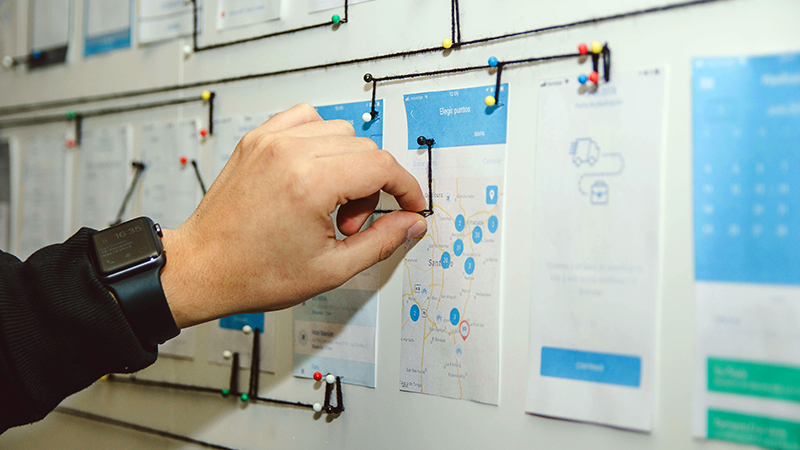Do you ever wonder why some websites are crowd-pleasers while others fizzle out faster than a campfire in a rainstorm? It all boils down to Discovery. Agencies prioritizing the importance of discovery on a project also understand that each one is different and needs to accommodate.
Think of it like this: without the discovery phase, you’re like that kid who skips studying or showing up to lecture, hoping to ace the test magically. Most of the time, they end up at the bottom of the class. However, those who try to understand and prepare are more likely to crush the exam. Or, in this case, launch a website that checks all the right boxes and functions well for its users.
“What’s the secret handshake?” You Ask?
The dividing line between web fame and web obscurity often hinges on whether a company invests the time in a discovery phase for its web projects. It’s the act of trading ignorance for insight, exchanging confusion for context.

So, What’s the Scoop on This Discovery Phase?
The name probably gave it away, but there’s more to it. It’s like the stretching session before a marathon. It’s a moment where the designer and client huddle together, piecing together the jigsaw puzzle of info needed to build a website that not just exists but excels.
The vital pieces of this puzzle could range from understanding the company’s clientele and their pain points to their brand presence and software integrations. Picture yourself doing some Sherlock Holmes-level investigation, interacting with the brand’s stakeholders to help form a full picture of what’s required. This investigative phase sets the stage for the development of dance.
At 3 Media Web, we believe in initiating every project with a thorough discovery phase. Our winning lottery ticket has enabled us to get our clients and their customers and pre-empt any potential curveballs.
So, next time you gear up for a website development project, remember – there’s no winning without discovery.
Six Ways Discovery Catapults Your Website Project to Success
The discovery phase is like giving your web development project the “Rocky” training montage it deserves. It’s a setup that gears the project for success.
Getting down to the nitty-gritty of discovery gives your business the kind of readiness that can put a boy scout to shame.
1. Discover Potential Pitfalls Before They Discover You
You’re familiar with the adage, “A stitch in time saves nine,” right? That’s the heart and soul of web development and launching a winning website.
A little forward thinking can help you see potential stumbling blocks before they see you. Knowing what’s coming lets you dodge or gear up to tackle it head-on.
2. Unearth the Features Your Visitors Will Dig
A solid understanding of the client’s customer needs and how they’ll use the site helps web builders tailor the website’s features, design, and flow.
After all, the goal isn’t just to create a website––it’s to craft a user experience the consumer will adore.
3. Build a Site Map That’s a Breeze to Navigate
It’s all about making the user’s quest for information on your site as effortless as a Sunday drive. Good web design achieves this with ease.
Discovery allows developers to chart the customer’s journey and align it with the company’s objectives. This helps to highlight the information and pages that need to be readily accessible on the site.
4. Discovery Lays Down a Budget That Won’t Buckle
Planning for unknowns can be as tricky as nailing jelly to a wall. If you dive into web development without a clear vision, offering a realistic quote to the client is hard.
Adding unplanned mid-project features can be as graceful as turning a freight train on a dime – it slows things down, consumes resources, and raises costs.
An upfront discovery phase lets developers lay eyes on the entire project terrain, thus enabling them to formulate a realistic timeline and budget.
5. Gauge Whether You Need Extra Manpower
The website creation journey is a multi-staged marathon involving design, content creation, website development, and post-launch updates. A discovery phase can help you determine what your internal team is equipped to handle or if more resources need to be allocated to the project.
This phase also allows you to strategize on content creation and digital marketing tactics. For example, if your site includes a blog, you’ll need a regular influx of articles. Discovery can help you assess if you need to hire a writer to generate content.
6. Pave the Way to a Speedy Launch
As the saying goes, “Measure twice, cut once.” This couldn’t be truer for web development timelines.
Ironically, companies often believe they can trim timelines by skimming over the discovery phase of a web development project. Yet, quite the opposite is true.

Getting Your Feet Wet with the Discovery Phase
There’s no sugarcoating it – the discovery process demands time and resources before you can expect any returns. As stated above, many companies hit the brakes on discovery, deeming it a waste.
But the truth is, without discovery, you’re embarking on your website development project without a compass. It’s like signing up for a treasure hunt without a map.
Some might shy away from discovery due to the mire of questions and scenarios it entails. The answers aren’t always on the nose, and you might wonder who within your organization is the oracle for certain questions.
Discovery can involve rounds of meetings with various teams, team leaders, and even third-party consultants. But like a strenuous hike, the view from the summit makes it all worthwhile.
The Discovery Phase Drill – What Are Some Common Questions Asked?
As you start the discovery, you search for specific data and information. That requires asking the right questions:
- What are the project’s goals? Put together a comprehensive list and get inputs from key personnel in the company.
- Is there a rival company that already offers a similar product or service? Identifying your competitors can provide valuable insights into their strengths and weaknesses.
- How can our company offer something fresh and exciting to wow site visitors? Learn from your competitors’ triumphs and pitfalls to shape a site that hooks visitors and keeps them returning.
- What are the significant project milestones? Start mapping out these steps and jot down all the work that needs to happen between them.
- What are realistic deadlines to reach these milestones? Establish timelines that are practical, not fantastical.
While these are just a few examples, the idea is to lay the foundation for problems that need solving. The better questions/answers, the better performance at the launch of the site.

No Pain, No Gain: A Discovery Phase Is Worth the Sweat
You might feel overwhelmed at the prospect of diving into your next project’s discovery phase. But it’s like hitting the gym–it seems daunting at first, but the rewards are well worth the effort.
You get to construct a clear plan for your project and side-step those pesky surprise problems that could dent your business time and money.
And let’s not forget most folks find that the discovery phase gives them peace of mind, and they even learn something new about their business strategy. Pouring in the effort during the discovery process means you’ll be sipping fewer stress cocktails over the next few weeks or months.
But don’t worry; you can always call in the expert team here at 3 Media Web, who know the ins and outs of a wide range of web projects and digital experience optimization. We have a proven process that repeatedly shows that we can save you money and time by swerving problems while planning to roll out your new project.
